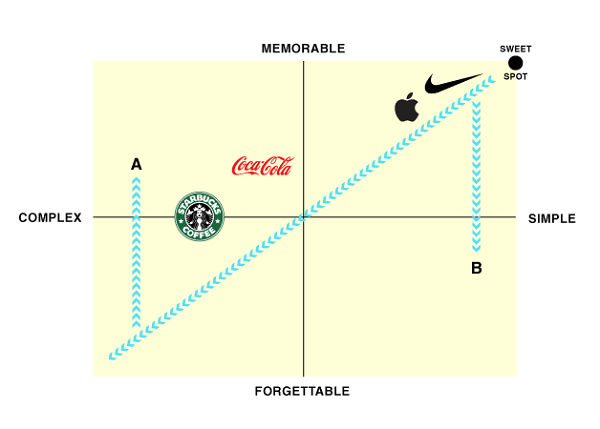Stop Designing Forgettable Logos

This guest post was written by Paul Galbraith, a freelance logo designer based in the UK, who works with clients worldwide to produce successful logos, identities and rebrands for all types of businesses.
###
With thousands of logos being created each year, it makes it extremely difficult for new ones to be designed that have something distinguishable to make them stand out, whilst staying simple enough to be memorable. This difficulty could well mean you’re producing logos that, although well designed, are far too forgettable to be successful for the businesses you’re designing them for.
Let’s be clear here, the main purpose of a logo is for it to act as an identifier of a company, so that over time it can become associated with that business and even a quick glimpse and consumers will instantly know who it represents. The main problem though, is that consumers don’t tend to examine logos, they usually only give them a fleeting look so it’s crucial that the logos you design can be viewed quickly but leave an impression, or they will never build that association. For this reason it’s worth examining in more detail the correlation between how simple or complex a logo design is and how memorable or forgettable that makes it, to see if any information can be gained that we can then use to our advantage when designing.
Where would your logos chart?
Take a look at the chart below, which is by no means scientific but nevertheless it’s useful for visualising the correlation we wish to examine. The x-axis depicts how detailed the logos are, from complex to simple, whilst the y-axis shows the ability to recall the logo, from memorable to forgettable. I’ve added a few well known logos so we can see how they might fit, to see if any patterns can be formed. As we would expect, the top right of the chart is where some of the iconic logomarks would go, therefore it would be great to have all our new logos appear here. However, because there are only a limited number of simple shapes available, to prevent copyright or trademark issues arising due to new logos being too similar to existing ones, it’s necessary to get more and more complex with the design to achieve some level of uniqueness. Because of the number of years this has been happening, it only seems logical now that it’s extremely hard to design a logo that could make it close to the sweet spot. Instead there seems to be a natural flow that happens due to the increase of logos over time (represented by the diagonal line) that goes from simple, memorable logos to complex, forgettable ones.

Where would the logos you’ve designed fit onto this chart? It’s always worth asking yourself this to see what action you could take with the design as there are ways to combat this natural flow, positively and negatively. Such as making a complex logo so identifiable that it breaks from that natural flow, instead rising, to become more memorable (A). Or making a simple logo so bland that it goes the opposite way, making it more forgettable (B). It’s worth bearing in mind with the logos used on this chart, that we have seen these hundreds of times, so we’re far more likely to remember them. However it’s the ones that are simple in design that we can recall better, rather than just have an impression of how they look. This could be demonstrated for example, if you were to ask consumers to sketch the logos of Nike or Apple. I’m sure a higher percentage would be able to reproduce a likeness to the original, than if you had asked them to draw those of Coca-Cola or Starbucks.
In relation to the Starbucks logo, it’s complex but it’s also quite memorable due to the mermaid figure and the black and green colour combination. However, rather than relying on those alone to build up the association with the Starbucks name, they choose to make the logo a combination mark so that the name will always be present within the design. Combination marks really help with reinforcing the name without having to use association, but can suffer in terms of usage. It’s much easier for example, to use a simple logomark at a small size than it is a combination mark, which often leaves the text unreadable.
There are of course companies that don’t use a logo mark at all, such as Coca-Cola, instead using just a wordmark/logotype. This again can help with name association, because it’s just the name and has no logo mark that could be used separately, thus no need to build an association. It could be said that this makes it easier, as the name will always be visible, however it can often be harder because there is no logo mark to add interest. All the work needs to be done with just the wordmark, thus the typeface/s and treatment used are even more critical to achieving unique simplicity.
Points to consider
Therefore, when designing a new logo it’s worth keeping in mind the following three points.
1. The more simple the logo is, the better. However, there is no point in it being so simple that it makes no impact or has nothing unique about it. Sometimes a clever, unexpected or humorous design can help a logo to stand out, just make sure it’s in keeping with the tone of the company. Also, don’t worry about the logo mark not being associable with the company initially. Many of the iconic logo marks that you see today, were not used on their own when they were first created, they were used in combination with the logo type. And it was only over time once consumers had made that association between the mark and the name, that the logo mark could then be used on it’s own and still recognised as the identifier of that business.
2. If you need to make the logo more complex then it’s important to consider how you’re going to make sure people remember it. They won’t take all of it in and if nothing catches their eye, then they won’t take any of it in. What you want to do is have at least one aspect that they will hopefully keep in mind. A good test can be to get a few friends or family members to take a quick glimpse of the logo and ask them to draw it. Hopefully there will be one part that they were able to draw, so if possible, work on simplifying that so it’s even more memorable. However, if they weren’t able to recreate any of it, then it’s unlikely consumers will remember any of it either, so work on it until they can.
3. It’s essential to get the logo to work in black only, this allows it to be used in many different applications and won’t leave it limited in the future. However, as stylish as a solid black logo can look, colour can be a really useful addition, especially with making your logos memorable. So don’t be afraid to try out various colours and combinations of colours, just be careful not to go wild.
Finally
When deciding on the sort of logo to use, be it a mark and type, a combination mark or just a wordmark, it’s worth considering the effect on memorability this choice will have. It’s easy to overlook some of the seemingly obvious aspects of logo design, especially when just starting out as a designer, or to get carried away with a design without really considering how memorable it may now be. Therefore, it’s worth keeping this in mind so that hopefully your next logo won’t be forgettable.
____
To stay updated with more great posts please subscribe to our RSS feed and follow us on Twitter.
What do you think it takes to design a memorable logo? Please leave your comments below. Thank you!
Image by DZPIXEL